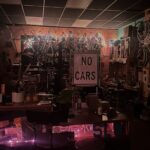When one considers how to help the homeless, perhaps one’s mind turns instantly to shelters and food banks, to sandwich-making and soup-serving. Non-profit organization Lava Mae, founded by Doniece Sandoval, has taken a rather unique approach to the issue.
Lava Mae is a project conceived by Sandoval to bring dignity through sanitation (clean, accessible showers, sinks, and toilets) to those who don’t have access to it: the homeless. Sandoval accomplishes this by providing a traveling hygiene haven to the needy in the form of a converted, decommissioned MUNI bus.
Sandoval believes that showers are a necessity that everyone should have access to –“everyone has a right to be clean,” Sandoval insists. Lava Mae’s values are exemplified on their business card: “Delivering dignity: one shower at a time.”
The organization was a Bay Area Impact Challenge finalist.
Sandoval first had the idea for Lava Mae when she “passed a young woman on the street crying over and over that she’d never be clean.” The project has attracted top-rate staff and volunteers to make Sandoval’s vision a reality: architect/designer Brett Terpeluk, community engagement and mobile services manager Leah Filler, mobile services coordinator Michael McMorrow, and identity sheriff Trish Richman. These talented people work together to create the cheerful environment I paid a visit to one sunny Saturday morning.

photo by Amanda Braitman ’15
The air had a crisp quality to it, and the volunteers and staff working each shower station were experienced and ran things smoothly. The Lava Mae bus was parked on a quiet street, hooked up to the fire hydrant at the corner. Cars rumbled past and people ambled by, enjoying the morning.
Inside the bus, the two shower units were spacious, well-lit, shiny and clean, the walls painted a bright blue. Each one included a mirror, shower, sink, toilet, hairdryer, hooks to hang belongings on, and a message board for clients to leave positive thoughts. One of the units was wheelchair accessible.
I struck up a conversation with one of the clients, Starleigh, originally from New Orleans. Starleigh represents everything Lava Mae works towards, a success story in the flesh. He couldn’t stop smiling after his 15-minute shower. His eyes were alight, and he was grinning from ear-to-ear, happy to rave about his experience. This was his first time at the Lava Mae bus.
“It puts people in the right perspective,” Starleigh said after his turn on the bus. “It felt so refreshing… They give you adequate time to do what you have to do… Serves a very good purpose. Makes people feel good about themselves.” Other clients expressed similar gratitude.
The professionalism of the Lava Mae staff came through in a crisis that Leah Filler, who was overseeing the day’s operations, handled. One of the Spanish-speaking clients was having an issue with the water temperature, and Leah, who didn’t know enough Spanish to assist, quickly and calmly recruited one of the other clients to translate. The situation was sorted out in a matter of minutes.
“Saying no at the end of the day” is the hardest part for Filler. The clients are respectful of the time constraints, but there just isn’t enough time to accommodate everyone. They understand that others are in need the amenities they are receiving from Lava Mae.
Filler talked about addressing the massive shortage of hygiene, the importance of giving the people who make use of the bus a sense of self-worth. By providing the homeless with an amenity we take for granted every day—being clean—Lava Mae helps break down people’s often negative perceptions of the homeless.
Lava Mae has a regular client base; Filler was on familiar terms with a lot of the people I saw filter through, but they also get new recruits, like Starleigh.
There are at least 7,350 homeless people in San Francisco. That means about 150 people without homes per square mile. Those who have homes are used to seeing and often ignoring the homeless curled up along the walls of underground MUNI and BART stations for warmth, sitting on street corners or tucked in alcoves with a bucket and perhaps a sign begging for something, anything. As Doniece Sandoval and Leah Filler stress, these people deserve to be noticed. Filler emphasized, “They’re just like us, a part of the community.”
Despite the thousands of homeless people in San Francisco, prior to Lava Mae there were only 7 locations with functioning showers where the homeless could bathe. Lava Mae is combatting this insufficiency one shower at the time with the motto “With hygiene comes dignity and with dignity, opportunity.”
A Lava Mae bus is “just two units that have a shower, sink, toilet, and a small changing area…. Even though you’re only going to be on the bus for twenty minutes or so, it’s twenty minutes of complete privacy and respite to hopefully recharge yourself in a lot of ways,” says Sandoval on the organization’s website.

photo by Amanda Braitman ’15
“Lava Mae is not about ending homelessness. What we are about is providing hygiene because we believe that hygiene brings dignity, and dignity opens up opportunity.”
Some cities have been successful in combating homelessness by transferring the homeless into housing, rather than the shelter system. I asked Filler whether that might be a good idea for San Francisco, but the reality is that the city wouldn’t be able to support that kind of investment with housing being as expensive as it is already.
Three more buses are scheduled to begin construction in January. Filler said the best way to help the organization is to spread the word. Donations are always welcome, as well as toiletry, sock, and underwear donation drives.
The Lava Mae concept is also currently being implemented in neighborhoods that are short on water because of California’s drought. Trailers are being parked on the borders between towns that have water and those that don’t, providing water for those desperately in need of it.





